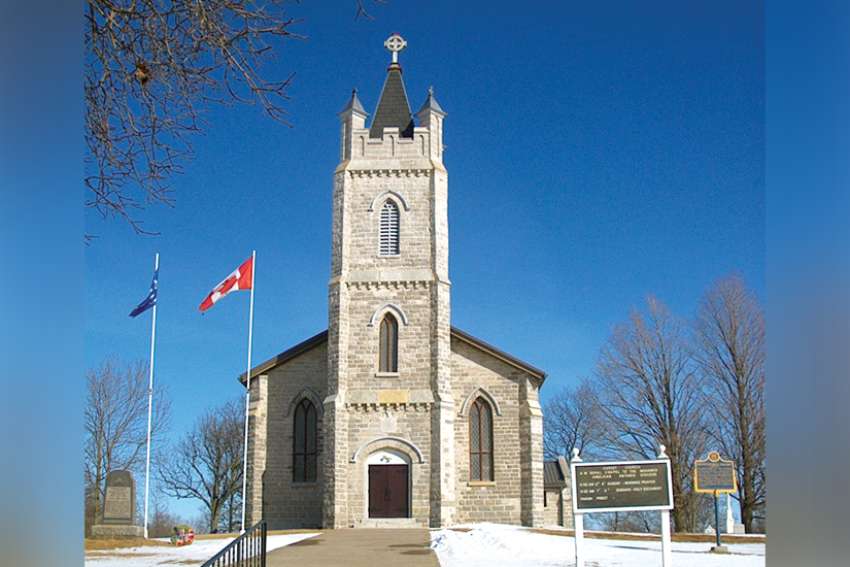Yet the majority of Indigenous peoples in Canada are Christians, and a great number of them are Catholics. Hence Catholic-Indigenous relations are not a matter of the Church dealing with those outside the household of faith, but those within the family as it were. That is often forgotten.
Thus I consider it a great blessing to have offered the Holy Mass for the Fourth Sunday of Advent at Christ Church, on the territory of the Mohawks of the Bay of Quinte, not far from Belleville, Ont. The local congregation there gave me a warm welcome, even adjusting their usual Mass time to accommodate my schedule.
We have spent a lot of time talking this year across the country — with each other, at each other, even against each other. It was good to pray together. Had the pandemic not intervened, this past Sunday Indigenous leaders would have had their third of four meetings with our Holy Father, Pope Francis. I suggested to the Mohawk congregation that we might keep that encounter, now postponed, in the intentions that we brought before the altar.
The history of Christ Church and that congregation is a remarkable one, a demonstration that our Catholic heritage is much more complex — and much richer — than we usually think.
The church commemorates the ties between the Mohawk people and the British Crown. It is officially designated as “Her Majesty’s Chapel Royal of the Mohawk Historic Site of Canada.” There is a stained glass window that depicts the arrival of the Mohawks to Tyendinaga territory on the Bay of Quinte. Mohawks had fought for the British Crown during the American Revolution, and after the American rebels had triumphed the “loyalist” Mohawks were forced out and came north along with other United Empire Loyalists.
These loyal Mohawks built a log church upon arrival. The first Christ Church was built in 1843, a testament to both their Christian faith and their prized relationship with the British Crown. Royal gifts over the years are a manifestation of this unusually close relationship. In 1904 King Edward VII conferred the title “His Majesty’s Chapel” on Christ Church. For the centennial of that designation, Queen Elizabeth II designated it a “Chapel Royal” in 2004, one of only two in Canada to be so designated.
Over the years the Victorian Gothic has been restored several times, most recently in the last decade by the same expert artisans, Ecclesiastical Refinishing Group, which did the re-design of my own parish church, Sacred Heart of Mary on Wolfe Island. It was from Mark Gray and his gifted colleagues that I first heard about the treasure of Christ Church.
Christ Church is proud of the various gifts given to the church by the sovereign, including a silver communion service from Queen Anne, a Bible from Queen Victoria and a chalice from Queen Elizabeth II. There are paintings in the sacristy corridor of the four Mohawk “kings” who travelled to Britain in 1710 to discuss an alliance against the French.
Over the altar is a triptych of the Apostles’ Creed, the Ten Commandments and the Lord’s Prayer, all written in the Mohawk language.
The history of the parish is Anglican, but in recent years the local Anglican parish moved to the nearby All Saints Church, and the local band council took over the administration of Christ Church.
A small group of Anglicans who wished to be Catholic entered full communion with the Catholic Church in 2011 under the provisions of Anglicanorum coetibus, the provision made by Benedict XVI for Anglicans to become Catholic while maintaining their Anglican patrimony.
This Catholic congregation worships as “Christ the King” community, and uses Christ Church on Sundays with the permission of the local band council. Fr. Richard Whalen of St. Michael’s in Belleville comes once a month for Sunday Mass, using the “Divine Worship” missal authorized by Pope Francis for these former Anglicans.
I have offered the Holy Mass according to “Divine Worship” a handful of times over the years, and find it a more beautiful liturgical expression of the riches of our own Roman Rite, notwithstanding its origins in Anglican worship. It was wise and generous of Pope Francis in 2015 to recognize the longstanding reality that the Roman Rite does not have only one expression, and the worship of the Church is enriched by the different expressions of the Roman Rite.
It is always “meet and right” — as the Divine Worship missal puts it — to pray together and to worship God fittingly. On Sunday at Christ Church, to offer the Holy Mass on a historic Mohawk site, in a chapel linked personally to the British Crown, with a congregation that is fully Catholic while cherishing their Mohawk and Anglican heritage — all this was a special grace at the end of a year in need of them.
(Fr. de Souza is founding editor of Convivium and a pastor in the Archdiocese of Kingston.)


